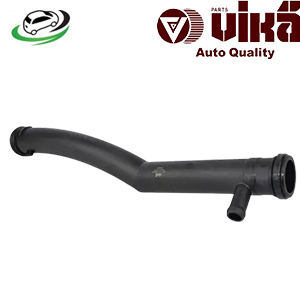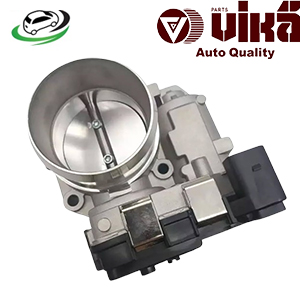-3%
Get A1 (8X1 8XK)/ A1 Sportback / VW CC B7 (358)/ EOS (1F7 1F8)/ Golf VI (5K1)/ Jetta III (1K2)/ Passat B6 (3C2) Throttle Body 03C133062AA
The throttle body is essentially a valve that controls the air intake of an engine. Located between the air filter and the intake manifold, it is the gateway through which air flows into the engine. In simpler terms, it controls how much air the engine takes in, directly influencing engine performance.
In older cars, the throttle body was connected to the accelerator pedal via a cable, which manually controlled a flap (butterfly valve) inside the throttle body. In modern vehicles, the throttle body is electronically controlled by sensors and actuators in what’s known as an electronic throttle control (ETC) system, often referred to as “drive-by-wire.”
2. How Does the Throttle Body Work?
The throttle body’s core function is to regulate the amount of air that enters the engine, helping maintain the ideal air-to-fuel ratio for combustion.
Here’s how the throttle body works:
- Throttle Valve: The main component inside the throttle body is a butterfly valve or flap, which opens and closes to control airflow. When you press the accelerator pedal, the valve opens, allowing more air into the engine. When the valve closes, airflow decreases, reducing power and slowing the vehicle down.
- Electronic Throttle Control (ETC): In modern vehicles, the throttle body is controlled electronically. The accelerator pedal is connected to a throttle position sensor (TPS), which sends a signal to the engine control unit (ECU) based on how far the pedal is pressed. The ECU then controls the throttle body’s actuator, adjusting the valve position for the right air intake.
- Air Intake: As the throttle valve opens, more air enters the engine through the intake manifold. The engine control unit (ECU) monitors the amount of air entering the engine and adjusts the fuel injectors to inject the correct amount of fuel. The air and fuel mix and ignite in the combustion chamber, powering the engine.
- Idle Air Control Valve (IACV): In many vehicles, the throttle body has an idle air control valve that maintains proper airflow when the engine is idling. The IACV adjusts airflow to prevent stalling or rough idling when the accelerator pedal is not pressed.
3. Components of the Throttle Body
A throttle body is made up of several essential parts that work together to regulate air intake:
1. Butterfly Valve
- The butterfly valve or throttle plate is a circular metal disc that pivots within the throttle body. It controls the flow of air into the engine. When the valve opens, air flows freely; when it closes, air is restricted.
2. Throttle Position Sensor (TPS)
- The throttle position sensor monitors the position of the throttle valve. It sends real-time data to the ECU, indicating how much the throttle is open. The ECU uses this information to adjust fuel delivery and optimize engine performance.
3. Throttle Actuator
- In vehicles with electronic throttle control, the throttle actuator is an electric motor that opens and closes the butterfly valve based on signals from the ECU. This replaces the manual cable found in older vehicles.
4. Idle Air Control Valve (IACV)
- The IACV manages the amount of air flowing into the engine when the vehicle is idling. It adjusts airflow to maintain stable engine operation during idle, preventing stalling or rough idle.
5. Airflow Sensor
- Some throttle bodies have an integrated mass airflow sensor (MAF) or manifold absolute pressure sensor (MAP) to measure the amount of air entering the engine, providing data to the ECU for precise fuel adjustment.
4. Types of Throttle Bodies
There are several types of throttle bodies, each suited to specific types of engines and vehicle configurations:
1. Cable-Operated Throttle Body
- Older vehicles use a cable-operated throttle body, where the throttle cable connects the accelerator pedal to the butterfly valve, mechanically opening and closing the valve as the driver presses the pedal.
2. Electronic Throttle Control (ETC) or Drive-By-Wire
- Modern vehicles use ETC systems, where there’s no physical connection between the accelerator pedal and throttle body. Instead, the throttle valve is controlled electronically by the ECU based on inputs from the throttle position sensor and other sensors.
3. Dual Throttle Body
- In high-performance or large-engine vehicles, a dual throttle body system may be used. This setup uses two throttle bodies to manage airflow into a V-engine or other high-capacity engines, improving responsiveness and air distribution.
4. Throttle Body with Integrated Sensors
- Some modern throttle bodies come with integrated sensors like the mass airflow sensor (MAF) or throttle position sensor (TPS) built directly into the unit, simplifying the overall design and enhancing control precision.
5. Benefits of a Throttle Body
The throttle body is a critical component that offers numerous benefits to the vehicle’s engine and overall performance:
1. Precise Air Intake Control
- The throttle body allows precise control over how much air enters the engine, enabling optimal air-fuel ratios for combustion. This improves fuel efficiency and power delivery.
2. Improved Engine Responsiveness
- A properly functioning throttle body ensures that the engine responds immediately to accelerator inputs. This leads to smoother acceleration and better control of engine power output.
3. Efficient Fuel Consumption
- By controlling the air-to-fuel ratio, the throttle body helps the engine burn fuel efficiently. This not only improves fuel economy but also reduces emissions.
4. Enhanced Engine Performance
- A throttle body that operates smoothly and efficiently can enhance engine performance, offering better acceleration and overall vehicle dynamics.
5. Better Emission Control
- Modern throttle bodies help regulate the amount of air entering the engine, which in turn helps control the amount of fuel burned. This leads to reduced emissions and helps vehicles comply with environmental regulations.
6. Common Problems with Throttle Bodies
Over time, throttle bodies can experience wear, dirt accumulation, or malfunctioning components. Here are some common issues:
1. Throttle Body Clogging
- Dirt and Carbon Buildup: Over time, dirt and carbon deposits can accumulate in the throttle body, obstructing airflow. This can lead to poor acceleration, rough idling, or stalling.
- Symptoms: The vehicle may experience reduced throttle response, poor fuel economy, or a check engine light may appear due to incorrect airflow readings.
2. Faulty Throttle Position Sensor (TPS)
- Sensor Malfunction: A faulty TPS can cause incorrect throttle readings, leading to erratic acceleration or poor engine performance.
- Symptoms: Delayed acceleration, uneven idle, engine misfires, or loss of power.
3. Electronic Throttle Body Failure
- Actuator Issues: The electronic throttle actuator can fail, preventing the butterfly valve from opening or closing properly.
- Symptoms: The vehicle may experience sudden power loss, hesitation during acceleration, or enter “limp mode” as a safety measure.
4. Vacuum Leaks
- Leaks in Throttle Body Gaskets: If the gasket sealing the throttle body to the intake manifold is damaged or worn, it can cause vacuum leaks, leading to poor engine performance.
- Symptoms: Rough idling, stalling, or a decrease in engine power.
7. Maintenance Tips for Throttle Bodies
Maintaining a clean and functional throttle body is key to ensuring smooth engine performance. Here are some essential maintenance tips:
1. Regular Cleaning
- Periodically cleaning the throttle body prevents dirt and carbon buildup, ensuring optimal airflow. Use a throttle body cleaner and a soft brush to remove deposits from the valve and surrounding surfaces.
2. Inspect Sensors
- Regularly inspect the throttle position sensor and other related sensors to ensure they are functioning correctly. Faulty sensors can cause inaccurate throttle control and should be replaced when necessary.
3. Check for Vacuum Leaks
- Inspect the throttle body gaskets for signs of wear or damage. If you detect a vacuum leak, replace the gasket to maintain proper air intake and engine performance.
4. Monitor Engine Idle
- If you notice rough idling, stalling, or poor acceleration, it may be time to inspect the throttle body for issues. Address any malfunctioning parts immediately to avoid further engine problems.
5. Replace Worn Parts
- Over time, components like the butterfly valve, sensors, and actuators can wear out. Replace any malfunctioning parts promptly to maintain smooth throttle control.
Conclusion
The throttle body is a crucial component in a vehicle’s air intake system, playing a direct role in controlling airflow into the engine and maintaining the optimal air-fuel ratio for combustion. Whether manually operated or electronically controlled, the throttle body affects engine responsiveness, fuel efficiency, and overall vehicle performance.
Follow us on Facebook for more parts.




Reviews
Clear filtersThere are no reviews yet.